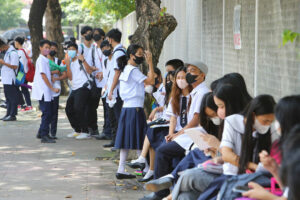




Quarterly Economic Growth Release: More BSP cuts to come
 DOWNLOAD
DOWNLOAD

Monthly Economic Update: Fed catches up
 DOWNLOAD
DOWNLOAD

Inflation Update: Steady and mellow
 DOWNLOAD
DOWNLOAD


Youth may lose up to 10% of future earnings due to learning losses


MILLIONS OF CHILDREN around the world could lose up to 10% of their future average annual earnings due to “education shocks” during the height of the coronavirus pandemic, a new World Bank report showed.
In the report “Collapse and Recovery: How COVID-19 Eroded Human Capital and What to Do About It,” the World Bank said the pandemic damaged the cognitive development and lifetime earnings of young people.
The decline in the cognitive and social-emotional development of toddlers due to the pandemic could also lead to a 25% reduction in future earnings as adults, it added.
“The pandemic and school closures threatened to wipe out decades of progress in building human capital. Targeted policies to reverse the losses in foundational learning, health, and skills are critical to avoid jeopardizing the development of multiple generations,” World Bank Group President David Malpass said in a separate statement.
The World Bank’s report was the first analysis of global data on young people who were under the age of 25 at the start of the pandemic in 2020. These young people will make up 90% of the “prime-age workforce” in 2050, it added.
When the pandemic hit in March 2020, widespread lockdowns were implemented to curb the spread of the coronavirus disease 2019 (COVID-19). This prompted school closures in 180 countries including the Philippines.
Around 1.3 billion children in low- and middle-income countries missed at least half a year of school, 960 million missed at least a full year and 711 million missed a year and a half or more, the World Bank said.
Between April 2020 and March 2022, Philippine schools were closed for 510 days, one of the longest school closures in the world. The Philippines only resumed full face-to-face classes for public and private schools in November 2022.
The World Bank noted these long school closures have led to deep learning losses. For every 30 days of school closures, students lost an average of about 34 days of learning. There was also a decline in enrollment even after schools reopened, it added.
“Learning losses can derail not only students’ learning trajectory but also their lives by diminishing their economic prospects, lifetime earnings, and chances of escaping poverty. If swift and effective actions are not taken, the pandemic-related schooling shock could leave students and economies permanently scarred,” the World Bank said.
The World Bank said there was an increase in learning poverty rates in low- and middle-income countries to 70% in 2022 from 57% in 2019.
“World Bank projections suggest that, globally, pandemic-related learning losses will lead to between $23,514 and $31,800 in lost earnings over a typical student’s lifetime. Overall, without urgent policy action, today’s students could lose as much as 10% of their future average annual earnings due to COVID-related learning losses. In terms of present value, these earnings could amount to $21 trillion — equivalent to 17% of today’s global GDP,” it said.
The pandemic also caused deep employment losses for the youth, the World Bank said.
“In most countries, youth employment (ages 15-24) fell sharply at the beginning of the pandemic. These declines were particularly pronounced in the Philippines, with a decline of 11 percentage points,” it added.
The World Bank said the number of hours worked by employed young people in the Philippines fell by 20 hours to just 19 hours a week during the pandemic.
“Adult employment has recovered, but youth employment has not. In the Philippines, the recovery of employment has also been larger among adults than youth,” it added.
The World Bank said that the government should implement policies and systems that can reverse learning losses.
“Reversing the pandemic’s impact on them and investing in their future should be a top priority for governments. Otherwise, these cohorts will represent not just a lost generation but rather multiple lost generations,” Norbert Schady, World Bank chief economist for human development, said.
The World Bank emphasized the need to keep schools open, increase instructional time, assess learning and match instruction to students’ learning level, implement targeted catch-up policies such as tutoring for children who have fallen behind, and streamline the curriculum to focus on foundational learning.
The government should also adopt measures to alleviate financial constraints to mitigate dropouts and encourage attendance.
The World Bank cited conditional cash transfers such as those in the Philippines, which were found to improve school enrollment and attendance.
It also noted adapted training, job intermediation, entrepreneurship programs, and new workforce-oriented initiatives to help boost youth employment. — Luisa Maria Jacinta C. Jocson
This article originally appeared on bworldonline.com





 By BusinessWorld
By BusinessWorld